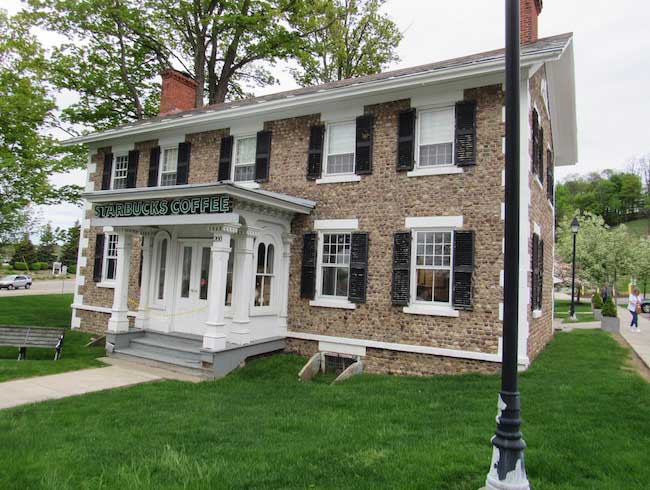Tour shows grand cobblestone buildings in Finger Lakes, including site that is a Starbucks
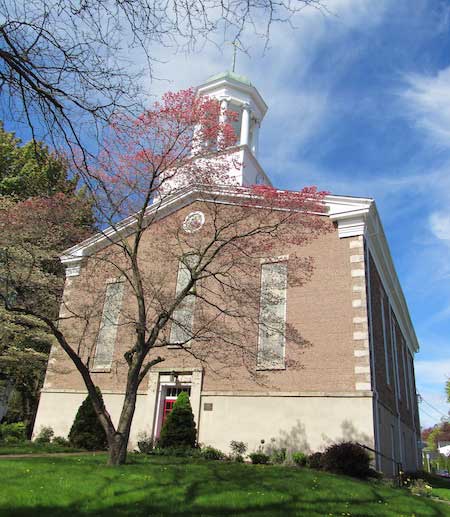
The first stop on the Cobblestone Museum’s cobblestone bus tour was the Webster Baptist Church, whose historian boasts it is the largest cobblestone building in the United States which has continually been used for its original purpose.
Those who took the Cobblestone Society Museum’s Cobblestone Bus Tour on Saturday enjoyed a day of sunshine, camaraderie and history of some very unusual attractions in the Monroe, Ontario and Wayne counties – most of them in cobblestone buildings.
There are 900 cobblestone buildings in New York state – the most of any state – and 700 of them are in the Rochester area, including many in Orleans County.
The tour passengers gathered at the Cobblestone Museum Saturday morning for juice and banana bread, which Sue Bonafini had brought from Grinds Café in Brockport.
Bonafini, who is assistant director for the Cobblestone Museum, also organized the day-long trip with museum director Doug Farley.
As the bus drove along Ridge Road, Bonafini pointed out historic cobblestone and other structures along the way, such as the spot where in 1810 DeWitt Clinton spent the night in a log cabin during his horseback trip across New York.
First stop on the trip was the Webster Baptist Church, where historian and board member Peter Elder proudly showed off the beautifully preserved building. The church boasts it is the largest cobblestone building in the United States which has continually been used for its original purpose.
Listed on the National Register of Historic Places in 1997, the church was built in the Civil War era and dedicated in 1857. Stones to build the church were collected, mostly by women, from the shores of Lake Ontario, from Seabreeze to Lakeside in Ontario County, and put in baskets to be loaded on barges. Elder said often they had to wait for storms to throw more stones up on the beach. It cost $150 to have the stones brought from Nine Mile Point to Webster. They were drawn by horse and wagon from the barges to Webster.
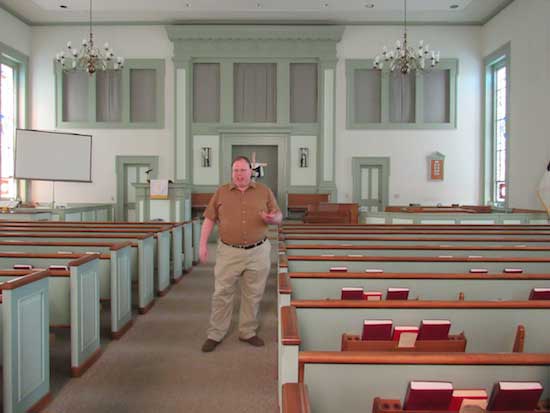
Peter Elder, historian and board member of the Webster Baptist Church, tells the church history to those on the Cobblestone bus tour Saturday. The chandeliers were installed during a 1904 renovation.
The congregation of the Webster Baptist Church numbers between 80 to 85, Elder said. The bell tower was once the talk of the town, being the first bell in Webster, he said.
The church also boasts one of only two Chapin organs in existence in the entire world. The organ was donated in 1938 by the family of William Wisner Chapin, a businessman for more than 40 years with the Monroe County Savings Bank. It is an Aeolian pipe organ, and its pipes wrap around the sanctuary, Elder said.
On Oct. 6, the church will be part of the Sacred Sites Tour, making it the oldest structure on the tour.
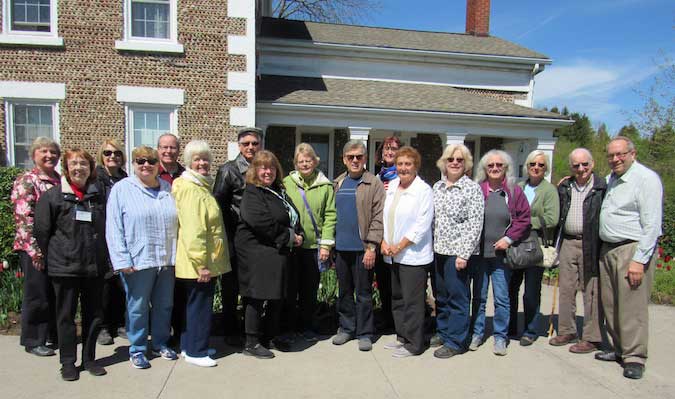
The Cobblestone bus tour group posed in front of the Martin Harris cobblestone home near Palmyra. The prophet Joseph Smith and his father once worked on the farm for Harris for 50 cents a day.
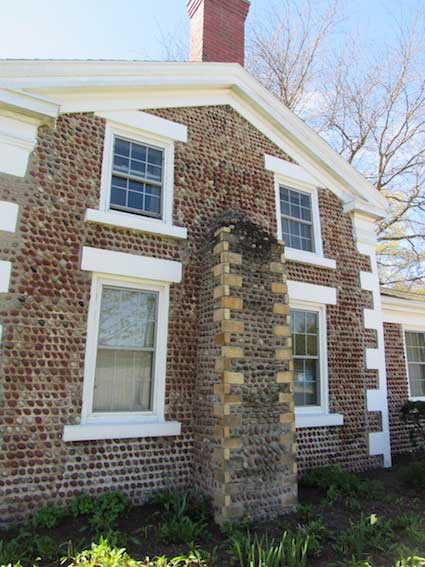
The Martin Harris home near Palmyra boasts this unique cobblestone chimney. The home is a New York state historic site.
Next stop on the tour was the Martin Harris Farm near Palmyra. The original home was a white frame house, which Harris occupied until 1831. The cobblestone structure was built by a mason and commissioned by William Chapman after the frame house burned down. The home, however, still bears the name of the original 1820’s landowner.
Harris bought the land for 50 cents an acre. He was a supporter of prophet Joseph Smith, who worked on the farm with his father for 50 cents a day. In 1829, Harris mortgaged 240 acres of his land for $3,000 to pay for printing of 5,000 copies of the first edition of the Book of Mormon. As a result, his wife left him.
Known as the Lake-Stone House, it is part of the Mormon Historic Sites Foundation.
In Palmyra, the group was greeted by docent Bonnie Hays at the Alling Coverlet Museum. It is named for Mrs. Merle Alling, a Rochester resident and coverlet collector. Staffed solely by volunteers, the museum opened in 1976 and is the only one in the country devoted to coverlets. About 60 coverlets are displayed every year, and it would take seven years to show the entire collection of more than 500.
Palmyra was once home to two noted weavers, James VanNess and Ira Hadsell. Hays explained Hadsell was a farmer, but could weave a coverlet in a day. He charged $2.50. In 1850, he weaved 221 coverlets, but by 1875 interest had declined and fewer than 25 were made.
One volunteer made a coverlet for the White House during the Carter years. Another who made coverlets was Sarah Hall Bonesteel, whose home was the cobblestone building in Newark, which is now a Starbucks and was the last stop on the tour. Bonesteel was the first woman to graduate from MIT and once tutored Helen Keller.
Hays stressed that one doesn’t wash a coverlet or use chemicals on them. Those on display are 120 to 150 years old, she said. She described weaving as a unique art form.
The museum also showcases antique looms, a third floor for quilts and a gift shop.
Mary Zangerle of Medina enjoyed looking at the quilts.
“I dabble in quilting, and I’m inspired by these,” she said.
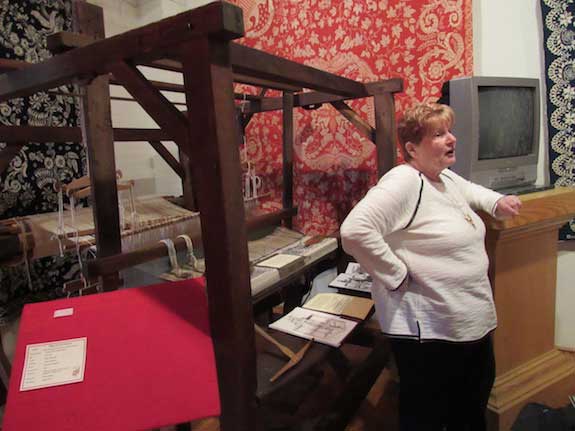
Bonnie Hays, a docent with the Alling Coverlet Museum in Palmyra, tells the museum’s history to the Cobblestone bus tour. It is the only museum in the country devoted to coverlets. Hays is standing in front of an 1809 barn loom.
Nearby was the Muddy Waters Café on the bank of the Erie Canal, our stop for lunch.
Then it was on to Newark and a stop at the Newark Historical Society and the Hoffman Clock Museum, located in the Newark Library across the street.
Among other displays relevant to Newark in the Historical Society, there is a room devoted to Sarah Coventry jewelry, which had its origin in Newark. From 1948 to 1984, Sarah Coventry was the largest direct selling jewelry company in the world. Visitors will learn that Newark was started in 1919 as a result of the canal. A lot of their displays center on the agriculture around Newark, a volunteer said. The June exhibit, now being constructed, will focus on farming and agriculture and Newark’s 200th anniversary.
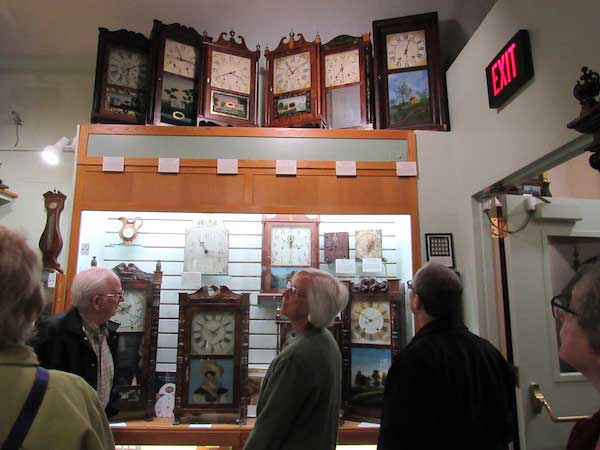
The group on the Cobblestone bus tour look at some of the clocks on display in the Hoffman Clock Museum in Newark. The museum has more than 400 clocks and watches. Checking out the display is Allan Kropf and Sandy Thaine of Medina and Jim Bonafini of Kendall.
At the Hoffman Clock Museum, curator Eric Hooker proudly described the clocks displayed. The museum represents a collection of 100 clocks owned by Augustus Hoffman, a jeweler in Lyons and Newark. He left an endowment to support the museum, which now boasts more than 400 clocks and watches. One prized clock in the collection is a Jenkins Brothers Clock, made in London and imported by Tiffany. Hooker said one of these clocks sold at auction for $15,000.
After “unwinding at the clock museum,” the tour headed for Starbucks in Victor to “get wound up.”
Starbucks purchased the historic cobblestone structure, built in the 1800s by Philip Bonesteel, to keep it from being destroyed. Bonesteel’s farm is now the Eastview Mall.
Heading back to Childs, Ann Raskopf of Olcott said she had recently joined the Cobblestone Society, and was now hooked on their events.
“I’m so excited about everything they have to offer,” Raskopf said. “This was a wonderful trip.”

















